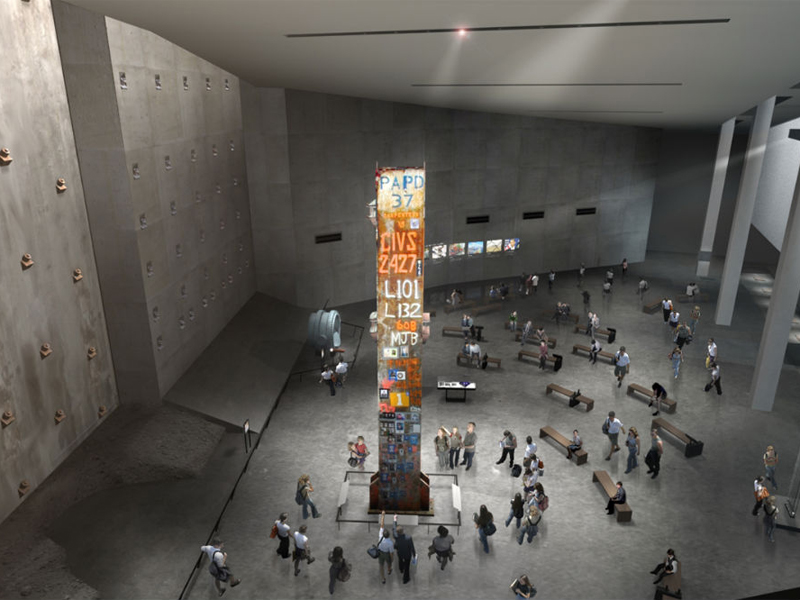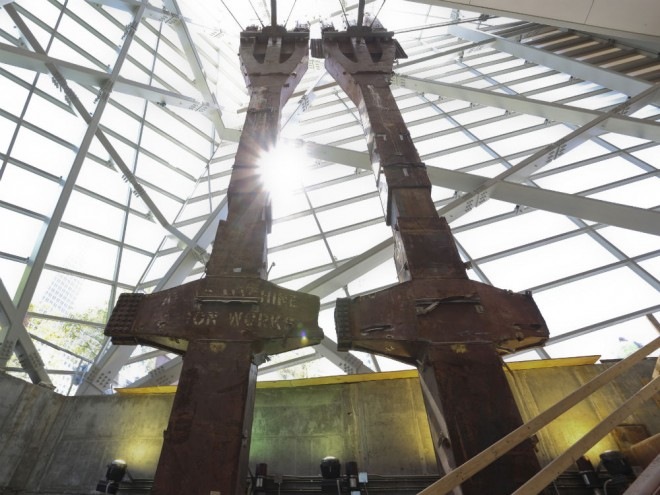By Liz Stinson Wired

The Last Column is a 36-foot-high steel beam that was the last steel removed from the site. Recovery workers covered it in photos of the lost and messages. 9/11 Museum
When the September 11 Memorial Museum opens this spring in the footprints of the two fallen towers, it will confront a very tricky challenge: How do you best memorialize a tragedy? It’s a tough question, and one the 9/11 Museum has answered with a beautifully designed building filled with personal stories and vestiges from the attacks that took place more than a decade ago.
When we talk about tragedy museums, we often look to places like the Holocaust Museum in Washington D.C. It’s a fair comparison, but there’s a key difference. The Holocaust Museum opened in 1993, decades after the horrific events occurred. This gave the museum a distance and a sense of historical perspective that the 9/11 museum can’t afford.
“We’re really aware of the fact that our visitors experienced this event,” says Amy Weisser, vice president for exhibitions at the museum. “9/11 is an ongoing historical moment that we all live in, so we’re not trying to tell visitors what happened as much as remind them what happened.”
The museum is ambitious—110,00 square feet of exhibition space nestled into the heart of the original World Trade Center site. From the lobby, a ramp guides visitors down to the lowest level, 70 feet underground. Along the way, a mediascape showcasing the personal stories of 9/11 from people around the world is meant to provide a bridge between present day and the event.
“We want people to turn to each other and say, ‘Did I ever tell you what happened to me?’” says Weisser. “We don’t want people to relive that day, but we want to put their experiences in a larger context.”
There are three main exhibitions, though large-scale artifacts will be scattered throughout the entire space like sculptures in an art museum. This includes pieces like recovered first response vehicles, a set of stairs survivors used to exit the World Trade Center [sic – the stairs led off the Plaza] and the “Last Column,” a 36-feet high steel beam that’s covered with mementos and memorial inscriptions.
These pieces are connected to the more tightly choreographed Historical Exhibition, which walks visitors through the events of the day. Videos, first-personal testimonials, images and artifacts will help craft the narrative and put the events into a historical context. While in the Memorial Exhibition, a much more personal story is being told. Upon entering the space, a series of 10-foot walls will showcase nearly 3,000 portraits of the people who lost their lives during and after the attacks. It’s a striking visual and is supplemented by multimedia screens that allow visitors to delve more deeply into each of the victims’ lives.

View of “Tridents”
Weisser says all but around 20 people are represented (due to difficulty locating photos and information). It’s a dizzying amount of information when you really think about it—a team of five full-time curators gathered photos, biographical information and in many cases an audio message from a family member, friend or colleague for thousands of people. It’s certainly more than a name on the wall, which was important, says Weisser. “We want our visitors to understand that we can tell the story of 9/11 because of the stories that were collected,” she says.
Taking a stroll through the museum, which officials estimate more than 2.5 million people each year will do, will undoubtedly be emotionally exhausting. But as the years pass by, the museum will stand as a physical reminder to generations far removed that this was more than a chapter in their history textbook. Books, movies and journalistic accounts will always be important, but Weisser explains that the museum is a chance for people to gain a much deeper understanding of what happened that day. “Even though we’re opening 12 years after the event, we are in many ways writing the initial history of 9/11,” she says. “This museum is going to be a major part of setting the ongoing narrative.”

